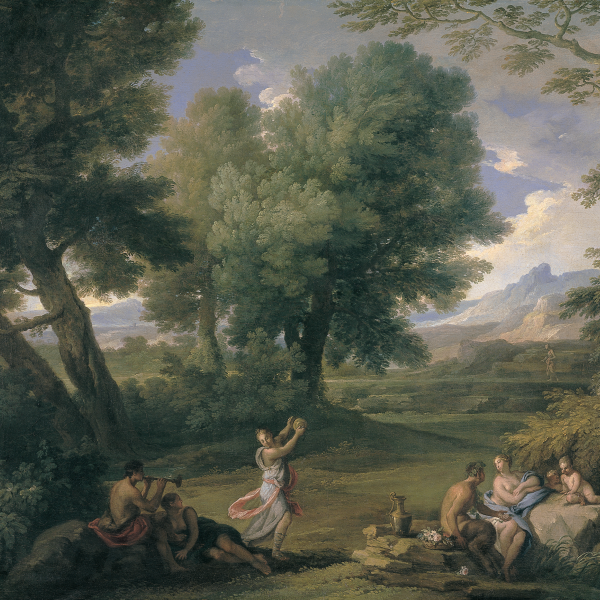Andrea Locatelli
Roma, 1695-1741
Locatelli, who was extremely famous in his own time, as is clear from the biography that Nicola Pio dedicated to him in 1724, owed his fame particularly to his views of the Roman countryside, which were impeccably painted though somewhat artificial. However, Locatelli had in fact trained as a painter of sea views in the workshops of very average artists, and as a painter of figures in the workshop of the Luccan artist Biagio Puccini.
Naturally, the 17th-century tradition of Roman landscape painting was fundamental to his development, both with regard to the views of ruins by Rosa and Ghisolfi (thus slightly anticipating Pannini), and to his own speciality, the idealised representation of the Lazio countryside. This trend saw contributions in particular from Emilian and Northern classicists such as Dughet and Lorrain; in fact, the former anticipated the taste for arboreal protagonism, later extolled by Locatelli himself.
With commissions from clients as important as the Ruspoli and Ottoboni families, by 1715 Locatelli is already documented as an active figure painter in some gouaches with sea views on the ground floor of Palazzo Ruspoli. Later, he painted sea views (which were destroyed) for the apartments of Cardinal Ottoboni at the Palazzo della Cancelleria. Among the extremely rare dated evidence enabling us to classify his works in chronological order (1721: Landscape with Figures by a Stream; unknown location; 1725: Landscape with Washerwomen, Viterbo, Count Savini; 1731: Landscape with Rebecca and Eliezer, Geneva, Musée d'Art et d'Histoire), of great importance are the glorious commissions, obtained through Juvarra, of views of the Castle of Rivoli, still not documented, (1723-1725, now in Turin, Castello di Racconigi) and two overdoors (1735) commissioned by Philip V of Spain for the Chinese room in the Palacio de San Ildefonso in Segovia. In 1736 he painted a Landscape with Herds and Shepherds, of unknown location (a lesser copy of a composition in a Bolognese private collection); two years later Locatelli decorated with four landscapes two doors in Palazzo Corsini. The diptych of the Národní Galerie in Prague (Peasants in Front of an Inn; Peasants by the Arch of Titus) dates from 1741, the year when Locatelli died, ill and destitute.
Entirely exceptional, in the context of his career as a painter of idealised landscapes (eighty paintings are mentioned in an inventory of Palazzo Colonna dating from 1783; over twenty were the property of the Barberini family) are the very few (all on copper) topographical views of Rome (which were, on the contrary, Pannini's speciality) among which is the Piazza Navona from the Gemäldegalerie der Akademie der Bildenden Künste in Vienna, dating from 1733.
Still difficult to answer is the question regarding interventions by other artists (identified by critics: Batoni, Subleyras.) as painters of figures in his works, particularly if it is true that Locatelli was himself a figure painter, as is clear from the genre scenes in the style of Bamboccio, which he painted in his later years.
Roberto Contini
Naturally, the 17th-century tradition of Roman landscape painting was fundamental to his development, both with regard to the views of ruins by Rosa and Ghisolfi (thus slightly anticipating Pannini), and to his own speciality, the idealised representation of the Lazio countryside. This trend saw contributions in particular from Emilian and Northern classicists such as Dughet and Lorrain; in fact, the former anticipated the taste for arboreal protagonism, later extolled by Locatelli himself.
With commissions from clients as important as the Ruspoli and Ottoboni families, by 1715 Locatelli is already documented as an active figure painter in some gouaches with sea views on the ground floor of Palazzo Ruspoli. Later, he painted sea views (which were destroyed) for the apartments of Cardinal Ottoboni at the Palazzo della Cancelleria. Among the extremely rare dated evidence enabling us to classify his works in chronological order (1721: Landscape with Figures by a Stream; unknown location; 1725: Landscape with Washerwomen, Viterbo, Count Savini; 1731: Landscape with Rebecca and Eliezer, Geneva, Musée d'Art et d'Histoire), of great importance are the glorious commissions, obtained through Juvarra, of views of the Castle of Rivoli, still not documented, (1723-1725, now in Turin, Castello di Racconigi) and two overdoors (1735) commissioned by Philip V of Spain for the Chinese room in the Palacio de San Ildefonso in Segovia. In 1736 he painted a Landscape with Herds and Shepherds, of unknown location (a lesser copy of a composition in a Bolognese private collection); two years later Locatelli decorated with four landscapes two doors in Palazzo Corsini. The diptych of the Národní Galerie in Prague (Peasants in Front of an Inn; Peasants by the Arch of Titus) dates from 1741, the year when Locatelli died, ill and destitute.
Entirely exceptional, in the context of his career as a painter of idealised landscapes (eighty paintings are mentioned in an inventory of Palazzo Colonna dating from 1783; over twenty were the property of the Barberini family) are the very few (all on copper) topographical views of Rome (which were, on the contrary, Pannini's speciality) among which is the Piazza Navona from the Gemäldegalerie der Akademie der Bildenden Künste in Vienna, dating from 1733.
Still difficult to answer is the question regarding interventions by other artists (identified by critics: Batoni, Subleyras.) as painters of figures in his works, particularly if it is true that Locatelli was himself a figure painter, as is clear from the genre scenes in the style of Bamboccio, which he painted in his later years.
Roberto Contini





